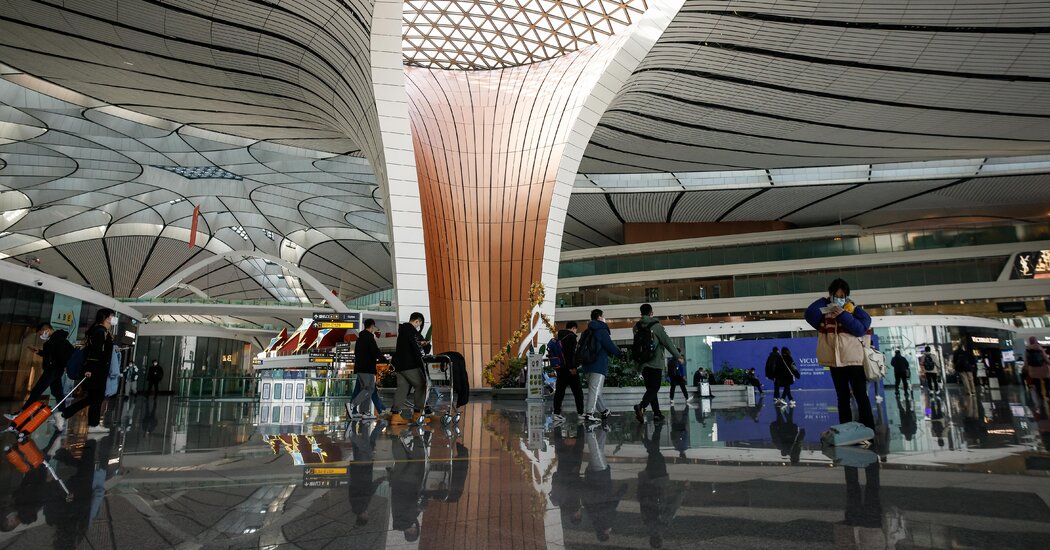China announced on Monday that travelers from abroad would no longer be required to quarantine on arrival, in one of the country’s most significant steps towards reopening since the start of the coronavirus pandemic.
From Jan. 8, inbound travelers will only be required to show a negative polymerase chain reaction or PCR test within 48 hours of departure, China’s National Health Commission said. Restrictions on the number of incoming flights will also be relaxed.
Travel restrictions had isolated the world’s most populous country for nearly three years. Foreigners were essentially banned from entering China in 2020, and even if they were allowed back in months later, it was generally only for business or family reunions.
Even some Chinese nationals were initially unable to return home, and travelers allowed in were required to undergo extensive health screening and quarantine at their own expense – sometimes for up to two months.
Monday’s announcement marked the latest turnaround in China’s “zero Covid” approach to the virus, which has seen Beijing try to stamp out infections for years. But the policies, which involved harsh and prolonged lockdowns of hundreds of millions of people, crushed the economy and fueled public discontent.
Understand the situation in China
The Communist Party rejected the restrictive ‘zero Covid’ policy, which sparked mass protests that posed a rare challenge to the Communist leadership.
In November, after a fire led to the deaths of 10 people in the Xinjiang region, with many people suspecting a Covid lockdown had hampered rescue efforts, protests erupted across the country. It was one of the boldest and most widespread outbursts of dissent in decades. Within days, the government began to ease restrictions.
The easing of travel restrictions “basically signals the definitive end to zero Covid,” said Yanzhong Huang, a senior fellow for global health at the New York-based Council on Foreign Relations. While China had eased many of its zero-Covid domestic policies this month — for example, abolishing regular mandatory testing for city residents and allowing home quarantine for those infected — it had stuck to its international restrictions.
However, the new measures do not mean that China will open its borders. Many details remained unclear. The government has not said when it will resume issuing tourist visas – all such visas that were valid at the start of the pandemic have been suspended. Officials said they would “further optimize” foreigners’ ability to apply for visas for business, study or family reunions, without giving specific details.
Chinese officials also did not say how many flights would be allowed to enter the country. In November, the number of international flights to China was 6 percent of what it was in 2019, according to flight tracker VariFlight.
China will also allow its citizens to travel abroad for leisure in an “orderly” manner, officials said. During the pandemic, the government stopped issuing or renewing passports of Chinese nationals except in limited circumstances, and in May said it would “strictly limit non-essential exit activities”.
The end of the international Covid quarantine was part of a wider announcement on Monday that China would lower its classification of the coronavirus. Previously, the government treated Covid-19 as a Category A infectious disease, similar to cholera or the bubonic plague. That classification required officials to introduce extensive restrictions to control the spread, including lockdowns and quarantines. Going forward, Covid will be treated as a category B disease, which includes AIDS and bird flu.
That change will further formalize China’s shift from zero Covid domestically, said Dr. Huang. While the earlier easing of restrictions had left local officials some leeway in deciding how soon to reopen, Beijing now signaled officials across the country to prioritize economic recovery over disease control, he said .
However, it was unclear how quickly international travelers would be willing to visit China and how much the economy would benefit. The recent easing of restrictions has led to an explosion in infections. Many elderly Chinese have not been vaccinated or have received only two vaccinations. The number of infections and deaths is also unclear as mass testing in the country has ended and China is counting Covid deaths differently from the rest of the world. But reports of overcrowded hospitals and funeral homes are widespread.
At a press conference on Sunday, an official in Zhejiang province, home to about 5 percent of China’s population, estimated there were more than a million new cases of Covid there per day.
Dr. Huang said that while China had been aiming for zero Covid for too long, he now feared that policymakers had moved too quickly in the opposite direction.
“I fear that the mitigation strategy that should focus on the elderly and the vulnerable will be put on the back burner,” he said.
The speed and shock of China’s Covid pivot has been reflected on its social media platforms, where users greeted the news of the rollback on Monday with a mix of disbelief and elation. Some celebrated the fact that Chinese students studying abroad would be able to return more easily to visit their families. In the minutes following the announcement, Chinese news media reported, searches for international airline tickets on one travel platform skyrocketed.
Others, however, said they couldn’t bring themselves to welcome the changes given the size of the outbreak and the number of deaths in China. Others noted that major parts of cities, including Beijing, were under lockdown less than a month earlier.
Claire Fu and Amy Chang Chien reporting contributed.

